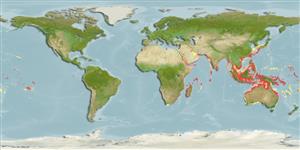Teleostei (teleosts) >
Carangiformes (Jacks) >
Carangidae (Jacks and pompanos) > Caranginae
Etymology: Alepes: Greek, alepis, -idos = without scales (Ref. 45335).
Environment: milieu / climate zone / depth range / distribution range
Ecology
Marine; reef-associated; amphidromous (Ref. 51243). Subtropical; 46°N - 37°S, 19°E - 138°W
Indo-Pacific: Red Sea and East Africa (Ref. 12484) to the Hawaiian Islands, north to Japan, south to Australia. Immigrant to the eastern Mediterranean through the Suez Canal, wetward to Malta (Ref. 33971).
Length at first maturity / Size / Weight / Age
Maturity: Lm 16.3 range ? - ? cm
Max length : 40.0 cm TL male/unsexed; (Ref. 11228); common length : 25.0 cm FL male/unsexed; (Ref. 3397); max. published weight: 603.00 g (Ref. 128705)
Adults form large schools near inshore reefs (Ref. 30573). Feed on shrimps, copepods, decapod larvae and other crustacean larvae and small fish (Ref. 5213, 90102). Eggs are pelagic (Ref. 4233). Often caught by ski-boat anglers in southern Africa (Ref. 12484).
Life cycle and mating behavior
Maturity | Reproduction | Spawning | Eggs | Fecundity | Larvae
Bauchot, M.-L., 1987. Poissons osseux. p. 891-1421. In W. Fischer, M.L. Bauchot and M. Schneider (eds.) Fiches FAO d'identification pour les besoins de la pêche. (rev. 1). Méditerranée et mer Noire. Zone de pêche 37. Vol. II. Commission des Communautés Européennes and FAO, Rome. (Ref. 3397)
IUCN Red List Status (Ref. 130435: Version 2025-1)
Threat to humans
Harmless
Human uses
Fisheries: commercial; gamefish: yes
Tools
Special reports
Download XML
Internet sources
Estimates based on models
Preferred temperature (Ref.
123201): 24.7 - 29, mean 28 °C (based on 1150 cells).
Phylogenetic diversity index (Ref.
82804): PD
50 = 0.5312 [Uniqueness, from 0.5 = low to 2.0 = high].
Bayesian length-weight: a=0.01349 (0.01205 - 0.01510), b=2.96 (2.93 - 2.99), in cm total length, based on LWR estimates for this species (Ref.
93245).
Trophic level (Ref.
69278): 3.6 ±0.54 se; based on food items.
Generation time: 1.8 ( na - na) years. Estimated as median ln(3)/K based on 2
growth studies.
Resilience (Ref.
120179): High, minimum population doubling time less than 15 months (K>0.3).
Fishing Vulnerability (Ref.
59153): Low vulnerability (18 of 100).
🛈
Climate Vulnerability (Ref.
125649): Moderate vulnerability (42 of 100).
🛈
Nutrients (Ref.
124155): Calcium = 48.5 [18.9, 86.5] mg/100g; Iron = 0.887 [0.489, 1.668] mg/100g; Protein = 20.3 [19.3, 21.4] %; Omega3 = 0.223 [0.137, 0.373] g/100g; Selenium = 16.3 [8.4, 32.1] μg/100g; VitaminA = 29.7 [9.9, 92.1] μg/100g; Zinc = 0.802 [0.534, 1.215] mg/100g (wet weight);
